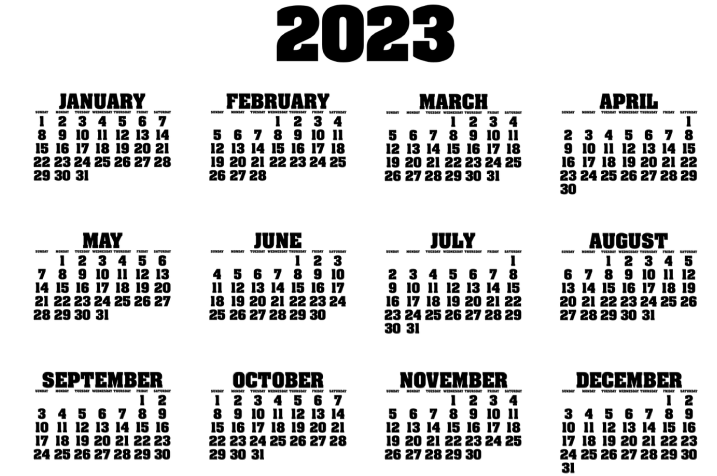How Many Weeks in a Year? Calculation and Table [2025 Step-by-Step Guide]
Have you ever wondered: “How many weeks in a year?” This seemingly basic question is more challenging than you might think. The number of weeks in a year varies based on the calendar system, leap years, and whether you consider work or school weeks.
n this comprehensive guide, we’ll go over the intricacies of determining how many weeks are in a year, give you with an online calculator and a table chart to show you how many weeks are in a year, and equip you with the knowledge to count weeks accurately using a step-by-step method.
Part 1. How Many Weeks Are in a Year?
There are 52 weeks in a common year
There are 52 weeks in a common year. The short answer is that the average number of weeks in a year is 52, with an additional day (52 weeks 1 day) in a standard Gregorian calendar year. However, the exact number of weeks can fluctuate depending on the calendar system and whether the year is a leap year.
#1. How Many Weeks Are There in a Gregorian Calendar Year?
In the Gregorian calendar, which is the most widely used civil calendar system worldwide, there are 52 weeks and 1 day in a standard year. This means that a Gregorian calendar year has 365 days, which can be divided into 52 weeks with 1 day left over. In a leap year, which occurs every 4 years (with some exceptions), there are 52 weeks and 2 days, resulting in 53 weeks in that particular year.

The specific calculation steps are:
Step 1: Determine the number of days in a year:
A typical year has 365 days.
A leap year has 366 days.
Step 2: Calculate the number of weeks:
There are 7 days in a week.
Step 3: Divide the total number of days by the number of days in a week:
For a typical year:A typical Gregorian calendar year has approximately 52 weeks and 1 day.

A leap year has approximately 52 weeks and 2 days.

#2. How Many Weeks in a Leap Year?
In a leap year, the Gregorian calendar has 366 days instead of the standard 365 days. This extra day means that there are 52 weeks and 2 days in leap years, resulting in a total of 53 weeks.

To calculate the number of weeks:
- Step 1: Total days in a leap year = 366
- Step 2: Number of days per week = 7
- Step 3: 366 days / 7 days per week = 52 weeks and 2 days
Since a week is 7 days, the 2 extra days beyond the 52 complete weeks means there are 53 total weeks in a year.
So the calculation is:
- Step 1: Intercalary year as 366 days
- Step 2: 366 days / 7 days per week = 52 weeks and 2 days
- Step 3: 52 weeks + 1 additional week (for the 2 extra days) = 53 weeks
Therefore, there are 53 weeks in a calendar leap year.
#3. How Many weeks in a school year
A typical school year is usually 9-10 months long, which translates to around 36-40 weeks. The exact number of weeks in a school year can vary depending on the specific academic julian calendar, but it is generally less than the 52 weeks in a standard calendar. The first week of a school year is often counted, even if it is not a full 7-day week.

Assuming a school year starts on September 1st and ends on June 10th, here’s the calculation:
- Step 1: Total days from September 1 to June 10 = 282 days
- Step 2: Number of days per week = 7
- Step 3: 282 days / 7 days per week = 40 weeks and 2 days
Since a week is defined as 7 days, the 2 extra days beyond the 40 complete weeks means there are 41 total weeks in a typical 9-10 month school year, including the first week.
So the full calculation is:
- Step 1: School year spans roughly 282 days
- Step 2: 282 days / 7 days per week = 40 weeks and 2 days
- Step 3: 40 weeks + 1 additional week (for the 2 extra days and the first week) = 41 weeks
Therefore, a standard 9-10 month school year in the Gregorian calendar typically has 41 weeks, including the week begins in the academic calendar.
#4. How Many Work Weeks in a Year
In common years, there are 52 weeks, which translates to 52 work weeks. However, it’s important to note that the number of actual work weeks may be slightly lower due to factors such as public holidays, vacation days, and other non-work days.
#5. How Many Weeks in a Year 2025
According to the 2025 Calendar (You can click here to download Calendar PDF for free), 2025 is a leap year, so there there are 366 days in this year.

Then, we can calculate the numbers of weeks in 2025, which is about 52.29 weeks, approximately 52 weeks.

Part 2. How to Calculate the Number of Weeks in a Year (With Online Calculator)
Weeks in a year can be easily calculated using a straightforward formula. The year calculation is a simple yet important task, as knowing the number of weeks in a year is essential for various planning and scheduling purposes. To calculate the number of weeks in a year, we need to consider the total number of days in a year and divide it by the number of days per week.

The specific steps to calculate the number of weeks in a year are as follows:
Step 1: Determine the total number of days in the year. In a standard Gregorian calendar year, there are 365 days. When asked that ”how many days in a leap year’, the answer is 366 days.
Step 2: Divide the total number of days by the number of days per week, which is 7.
- For a 365-day year: 365 days / 7 days per week = 52 weeks and 1 day
- For a 366-day leap year: 366 days / 7 days per week = 52 weeks and 2 days
Step 3: Since a week is defined as 7 consecutive days, the extra day(s) beyond the complete weeks are not counted as a full week.
Step 4: Therefore, in a standard year, there are 52 weeks, and in a intercalary year, there are 53 weeks.
The key takeaway is that a year typically has 52 weeks, but a intercalary year has 53 weeks due to the additional day.
If your child has questions about the above calculation steps, or you want your child to further improve his calculation ability, you can take a free online 1-on-1 math trial class by WuKong Math, and you can also get free math calculation worksheets after the class.
Discovering the maths whiz in every child,
that’s what we do.
Suitable for students worldwide, from grades 1 to 12.
Get started free!Online Calculator to Court Weeks in a year
Several online tools and calculators can help you quickly calculate weeks in a particular year. These calculators often take into account factors like leap years and can provide the exact number of weeks, as well as other relevant information about the year.
Filing Date Calculator
URL: https://www.esquiresolutions.com/services/court-reporting/esquire-filing-date-calculator/

To use the Filing Date Calculator on the Esquire Deposition Solutions website to determine court weeks in a year, follow these steps:
| Step | Description |
|---|---|
| 1. Access the Calculator | Visit the Filing Date Calculator. |
| 2. Enter Start Date | Input a date within the year you want to calculate (e.g., “01/01/2025”). |
| 3. Specify Number of Days | Enter 7 days for one week. For multiple weeks, adjust accordingly (e.g., enter 28 for 4 weeks). |
| 4. Choose Direction | – After Start Date: To find a future deadline. – Before Start Date: To find a past deadline. |
| 5. Exclude Weekends and Holidays | Decide whether to exclude weekends and federal holidays. Check this option if you want to consider only court days. |
| 6. Calculate | Click to calculate, and the deadline will appear below. |
| 7. Repeat | To find additional court weeks, adjust the start date and number of days as needed. |
Deadline calculator
URL: https://lawtoolbox.com/deadline-calculator/

Part 3. Weeks in a Year Table Chart by Year
Number of Weeks vary depending on the calendar system and whether it’s a leap year. Let’s take a look at the how many weeks in a year for the upcoming decade from 2025 to 2035. This will help us understand how the number of weeks can fluctuate from year to year, with the weeks ranging from 52 to 53 depending on the specifics of each year. Here’s a table showing the number of weeks in a year from 2015 to 2035.
The table covers the years from 2015 to 2035, providing the information on whether each year is a leap year and the corresponding number of weeks in that year. As you can see, the standard number of full weeks in a year is 52, with an additional day or two in intercalary years. The extra day(s) beyond the 52 complete weeks do not constitute a full 53rd week, though some calendars may still count them as such.
Weeks in a Year Table Chart – Download PDF for Free
| Year | Is Leap Year | Weeks in a Year (weeks + day) |
| 2015 | No | 52 weeks + 1 day |
| 2016 | Yes | 52 weeks + 2 days |
| 2017 | No | 52 weeks + 1 day |
| 2018 | No | 52 weeks + 1 day |
| 2019 | No | 52 weeks + 1 day |
| 2020 | Yes | 52 weeks + 2 days |
| 2021 | No | 52 weeks + 1 day |
| 2022 | No | 52 weeks + 1 day |
| 2023 | No | 52 weeks + 1 day |
| 2025 | Yes | 52 weeks + 2 days |
| 2025 | No | 52 weeks + 1 day |
| 2026 | No | 52 weeks + 1 day |
| 2027 | No | 52 weeks + 1 day |
| 2028 | Yes | 52 weeks + 2 days |
| 2029 | No | 52 weeks + 1 day |
| 2030 | No | 52 weeks + 1 day |
| 2031 | No | 52 weeks + 1 day |
| 2032 | Yes | 52 weeks + 2 days |
| 2033 | No | 52 weeks + 1 day |
| 2034 | No | 52 weeks + 1 day |
| 2035 | No | 52 weeks + 1 day |
The Year 2025 In Weeks – Download PDF for Free
| Week | Starting Date | End Date |
|---|---|---|
| 1 | 2025-01-01 | 2025-01-07 |
| 2 | 2025-01-08 | 2025-01-14 |
| 3 | 2025-01-15 | 2025-01-21 |
| 4 | 2025-01-22 | 2025-01-28 |
| 5 | 2025-01-29 | 2025-02-04 |
| 6 | 2025-02-05 | 2025-02-11 |
| 7 | 2025-02-12 | 2025-02-18 |
| 8 | 2025-02-19 | 2025-02-25 |
| 9 | 2025-02-26 | 2025-03-03 |
| 10 | 2025-03-04 | 2025-03-10 |
| 11 | 2025-03-11 | 2025-03-17 |
| 12 | 2025-03-18 | 2025-03-24 |
| 13 | 2025-03-25 | 2025-03-31 |
| 14 | 2025-04-01 | 2025-04-07 |
| 15 | 2025-04-08 | 2025-04-14 |
| 16 | 2025-04-15 | 2025-04-21 |
| 17 | 2025-04-22 | 2025-04-28 |
| 18 | 2025-04-29 | 2025-05-05 |
| 19 | 2025-05-06 | 2025-05-12 |
| 20 | 2025-05-13 | 2025-05-19 |
| 21 | 2025-05-20 | 2025-05-26 |
| 22 | 2025-05-27 | 2025-06-02 |
| 23 | 2025-06-03 | 2025-06-09 |
| 24 | 2025-06-10 | 2025-06-16 |
| 25 | 2025-06-17 | 2025-06-23 |
| 26 | 2025-06-24 | 2025-06-30 |
| 27 | 2025-07-01 | 2025-07-07 |
| 28 | 2025-07-08 | 2025-07-14 |
| 29 | 2025-07-15 | 2025-07-21 |
| 30 | 2025-07-22 | 2025-07-28 |
| 31 | 2025-07-29 | 2025-08-04 |
| 32 | 2025-08-05 | 2025-08-11 |
| 33 | 2025-08-12 | 2025-08-18 |
| 34 | 2025-08-19 | 2025-08-25 |
| 35 | 2025-08-26 | 2025-09-01 |
| 36 | 2025-09-02 | 2025-09-08 |
| 37 | 2025-09-09 | 2025-09-15 |
| 38 | 2025-09-16 | 2025-09-22 |
| 39 | 2025-09-23 | 2025-09-29 |
| 40 | 2025-09-30 | 2025-10-06 |
| 41 | 2025-10-07 | 2025-10-13 |
| 42 | 2025-10-14 | 2025-10-20 |
| 43 | 2025-10-21 | 2025-10-27 |
| 44 | 2025-10-28 | 2025-11-03 |
| 45 | 2025-11-04 | 2025-11-10 |
| 46 | 2025-11-11 | 2025-11-17 |
| 47 | 2025-11-18 | 2025-11-24 |
| 48 | 2025-11-25 | 2025-12-01 |
| 49 | 2025-12-02 | 2025-12-08 |
| 50 | 2025-12-09 | 2025-12-15 |
| 51 | 2025-12-16 | 2025-12-22 |
| 52 | 2025-12-23 | 2025-12-29 |
| 53 | 2025-12-30 | 2025-01-05 |
Part 4. Facts About Weeks That You Should Konw
While the concept of weeks in a year may seem straightforward, there are some interesting facts about weeks that you may not be aware of:
- The Gregorian calendar follows the lunar cycle, which is approximately 29.5 days long.
- The Babylonians rounded this to 28 days and divided it into 4 weeks of 7 days each.
- The days of the week are named after various celestial bodies and gods in different cultures.
- While the international standard defines the week as starting on Monday, the U.S. norm is still to consider Sunday as the first day of the week.
FAQ about How Many Weeks in a Year
Q 1. Is 52 weeks exactly a year?
- The 52 weeks in a standard calendar are not evenly distributed across the 12 months.
- The number of weeks in a month can range from 4 to 5, depending on the number of days in the month and the starting day of the week.
Q 2. How Many Full Weeks are There in a Year?
In a standard 365-day year, there are 52 full weeks, as the total number of days (365) divided by the number of days per week (7) results in 52 weeks with 1 extra day. In a 366-day leap year, the calculation is the same – 366 days divided by 7 days per week equates to 52 full weeks with 2 extra days.
The extra 1 or 2 days beyond the 52 complete weeks do not constitute an additional full week, even though a leap year has 53 total weeks. Therefore, whether it’s a regular year or a leap year, the number of full weeks in a year is 52.
Q 3. How Many Weeks in a Year 2023
In the year 2023, there are 52 weeks in a normal year.

Q 5.How many weeks in a month
The number of weeks in a month can range from 4 to 5, depending on the number of days in the month and the starting day of the week.
Q 6. How many bi-weekly pay periods in a year
In a standard 52-week year, there are 26 bi-weekly pay periods.
Q 7. How Many Months in a Year Have 5 Weeks?
Typically, 3-4 months in a year have 5 weeks, depending on the starting day of the week and the number of days in the month.
Q 8. How Many 2 Week Pay Periods in a Year
In a standard 52-week year, there are 26 two-week pay periods.
Q 9. How to Calculate the Number of Last Week in a Year?
For a standard 365-day year, the last week is week 52 since the total days (365) divided by 7 days per week equals 52 complete weeks plus 1 extra day. But in a 366-day leap year, the extra day means the last week is week 53, as the total days (366) divided by 7 equals 52 weeks plus 2 days.
Conclusion
In conclusion, the number of weeks in a year is a fundamental concept that is crucial for various aspects of our lives, from personal scheduling to business operations. While the standard answer is 52 weeks, the exact number can vary depending on factors like the calendar system and whether the year is a leap year. By understanding the nuances of calculating weeks in a year, you can ensure accurate planning and decision-making. Remember, knowledge is power, and mastering the details of weeks in a year can give you a significant advantage in both your personal and professional endeavors.
Related Articles

My name is Kaia Bennett, and I graduated from Tianjin Foreign Studies University. With a strong background in education, parenting, economics, AI, sports, and health, I have dedicated my career to writing and sharing insights in these fields. Over the years, I have gained extensive experience as an English guest blogger, contributing to various platforms. Currently, I write for WuKong Education, where I focus on sharing learning experiences with a global audience of teenagers. My goal is to inspire and empower young minds through engaging and informative content.




![Math League: Competitions, Challenges, and Achievements [2025 Full Guide] Math League: Competitions, Challenges, and Achievements [2025 Full Guide]](https://wp-more.wukongedu.net/blog/wp-content/uploads/2024/01/school-2353406-520x293.jpg)




![2025 Guide for AP Chinese Exam [With Practice Tests PDF] 2025 Guide for AP Chinese Exam [With Practice Tests PDF]](https://wp-more.wukongedu.net/blog/wp-content/themes/motioners/img/thumb-medium.png)
![6 Best English Classes for Beginners: How to Learn? [2025 Guide] 6 Best English Classes for Beginners: How to Learn? [2025 Guide]](https://wp-more.wukongedu.net/blog/wp-content/uploads/2024/01/image-377-520x293.png)

Comments0
Comments